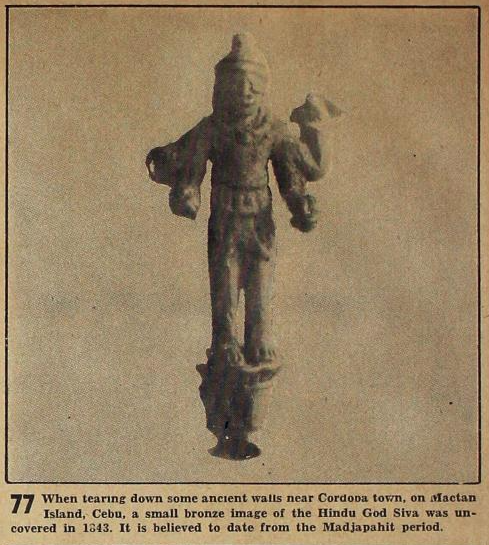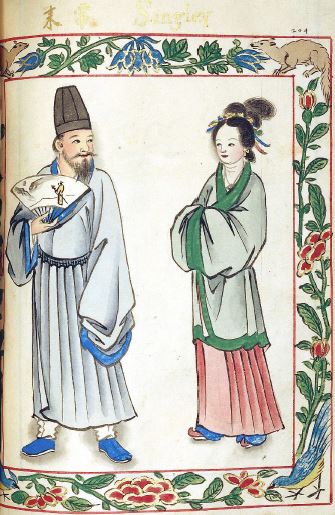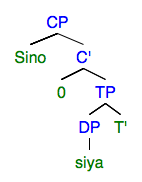|
Lapu-Lapu
Lapulapu (fl. 1521) or Lapu-Lapu, whose name was first recorded as Çilapulapu, was a datu (chief) of Mactan, an island now part of the Philippines. Lapulapu is known for the 1521 Battle of Mactan, where he and his men defeated Spanish forces led by Portuguese explorer Ferdinand Magellan and his native allies Rajah Humabon and Datu Zula. Magellan's death in battle ended his voyage of circumnavigation and delayed the Spanish occupation of the islands by over forty years until the expedition of Miguel López de Legazpi which reached the archipelago in 1565. Modern Philippine society regards him as the first Filipino hero because of his resistance to Spanish colonization. Monuments of Lapulapu have been built all over the Philippines to honor Lapulapu's bravery against the Spaniards. The Philippine National Police and the Bureau of Fire Protection use his image as part of their official seals. Besides being a rival of Rajah Humabon of neighboring Cebu, very little is rel ... [...More Info...] [...Related Items...] OR: [Wikipedia] [Google] [Baidu] |
Datu
''Datu'' is a title which denotes the rulers (variously described in historical accounts as chiefs, sovereign princes, and monarchs) of numerous Indigenous peoples throughout the Philippine archipelago. The title is still used today, though not as much as early Philippine history. It is a cognate of ''datuk'', ''dato'', and ''ratu'' in several other Austronesian languages. Overview In early Philippine history, ''datus'' and a small group of their Cognatic kinship, close relatives formed the "apex stratum" of the traditional three-tier social hierarchy of lowland Philippine societies. Only a member of this birthright aristocracy (called ''maginoo'', ''nobleza'', ''maharlika'', or ''timagua'' by various early chroniclers) could become a ''datu''; members of this elite could hope to become a ''datu'' by demonstrating prowess in war or exceptional leadership. In large coastal polities such as those in Maynila (historical polity), Maynila, Tondo (historical polity), Tondo, Pangasi ... [...More Info...] [...Related Items...] OR: [Wikipedia] [Google] [Baidu] |
Rajahnate Of Cebu
Cebu, also called Sugbu, informally referred to as the Rajahnate of Cebu, was an Indianized mandala (polity) monarchy on the island of Cebu in the Philippines prior to the arrival of the Spanish conquistadors. It is known in ancient Chinese records as the nation of Sokbu (束務) ( Hokkien) or Suwu ( Mandarin).SONG, MING, AND OTHER CHINESE SOURCES ON PHILIPPINES-CHINA RELATIONS By Carmelea Ang See. Page 74. According to Visayan oral legend, it was founded by Sri LumaySantarita, J. B. (2018). Panyupayana: The Emergence of Hindu Polities in the Pre-Islamic Philippines. Cultural and Civilisational Links Between India and Southeast Asia, 93–10 ... [...More Info...] [...Related Items...] OR: [Wikipedia] [Google] [Baidu] |
Carlos Calao
Carlos may refer to: Places ;Canada * Carlos, Alberta, a locality ;United States * Carlos, Indiana, an unincorporated community * Carlos, Maryland, a place in Allegany County * Carlos, Minnesota, a small city * Carlos, West Virginia ;Elsewhere * Carlos (crater), Montes Apenninus, LQ12, Moon; a lunar crater near Mons Hadley People * Carlos (given name), including a list of name holders * Carlos (surname), including a list of name holders Sportspeople * Carlos (Timorese footballer) (Carlos Mateus Ximenes, born 1986) * Carlos (footballer, born 1995) (Carlos Alberto Carvalho da Silva Júnior), Brazilian footballer * Carlos (footballer, born 1985) (Carlos Santos de Jesus), Brazilian footballer Others * Carlos (Calusa) (died 1567), king or paramount chief of the Calusa people of Southwest Florida * Carlos (singer) (1943—2008), French entertainer * Carlos the Jackal, a Venezuelan terrorist Arts and entertainment * ''Carlos'' (miniseries), 2010 biopic about the terrorist Carlo ... [...More Info...] [...Related Items...] OR: [Wikipedia] [Google] [Baidu] |
Mestizo De Sangley
Sangley (English plural: ''Sangleys''; Spanish plural: ''Sangleyes'') and Mestizo de Sangley (Sangley mestizo, ''mestisong Sangley'', ''chino mestizo'' or Chinese mestizo) are archaic terms used in the Philippines during the Spanish colonial era to describe respectively a person of pure overseas Chinese ancestry and a person of mixed Chinese and native Filipino ancestry. The Sangley Chinese were ancestors to both modern Chinese Filipinos and modern Filipino mestizo descendants of the ''Mestizos de Sangley,'' also known as Chinese mestizos, which are mixed descendants of Sangley Chinese and native Filipinos. Chinese mestizos were ''mestizos'' (mixed peoples) in the Spanish Empire, classified together with other Filipino mestizos. The Spanish had such categories as indios ( for natives of the East Indies), (descendants of colonial ethnic Spanish and native-born Filipinos), the ''tornatrás'' (Spanish-Chinese mestizos, descendants of colonial Spanish Filipinos and Sangley Ch ... [...More Info...] [...Related Items...] OR: [Wikipedia] [Google] [Baidu] |
Prudencio De Sandoval
Fray Prudencio de Sandoval (1553–1620) was a Spanish historian and Benedictine monk, the Bishop of Tuy from 1608 to 1612 and Bishop of Pamplona thereafter until his death. De Sandoval was born in Valladolid. He continued the chronicle begun by Florián de Ocampo and Ambrosio de Morales, and rather uncritically compiled a large collection of documents, making much use of Guevara y Mejía. His ''Historia de la vida y hechos del emperador Carlos V'' is a source of fundamental importance for the reign of Charles V, Holy Roman Emperor. His ''Historia de los reyes de Castilla y León'' or ''Historia de los cinco reyes'' (Pamplona: 1615) includes some documentary and epigraphic material now lost. He died in Pamplona Pamplona (; ), historically also known as Pampeluna in English, is the capital city of the Navarre, Chartered Community of Navarre, in Spain. Lying at near above sea level, the city (and the wider Cuenca de Pamplona) is located on the flood pl ..., and his last ... [...More Info...] [...Related Items...] OR: [Wikipedia] [Google] [Baidu] |
Sanskrit
Sanskrit (; stem form ; nominal singular , ,) is a classical language belonging to the Indo-Aryan languages, Indo-Aryan branch of the Indo-European languages. It arose in northwest South Asia after its predecessor languages had Trans-cultural diffusion, diffused there from the northwest in the late Bronze Age#South Asia, Bronze Age. Sanskrit is the sacred language of Hinduism, the language of classical Hindu philosophy, and of historical texts of Buddhism and Jainism. It was a lingua franca, link language in ancient and medieval South Asia, and upon transmission of Hindu and Buddhist culture to Southeast Asia, East Asia and Central Asia in the early medieval era, it became a language of religion and high culture, and of the political elites in some of these regions. As a result, Sanskrit had a lasting effect on the languages of South Asia, Southeast Asia and East Asia, especially in their formal and learned vocabularies. Sanskrit generally connotes several Indo-Aryan languages# ... [...More Info...] [...Related Items...] OR: [Wikipedia] [Google] [Baidu] |
Honorific
An honorific is a title that conveys esteem, courtesy, or respect for position or rank when used in addressing or referring to a person. Sometimes, the term "honorific" is used in a more specific sense to refer to an Honorary title (academic), honorary academic title. It is also often Conflation, conflated with systems of Honorifics (linguistics), honorific speech in linguistics, which are grammatical or morphology (linguistics), morphological ways of encoding the relative social status of speakers. Honorifics can be used as prefixes or suffixes depending on the appropriate occasion and presentation in accordance with Style (form of address), style and Convention (norm), customs. Typically, honorifics are used as a Style (manner of address), style in the grammatical third Grammatical person, person, and as a form of address in the second person. Some languages have anti-honorific (''despective'' or ''humilific'') first person forms (expressions such as "your most humble servant" ... [...More Info...] [...Related Items...] OR: [Wikipedia] [Google] [Baidu] |
Carlo Amoretti
Carlo Amoretti (born 16 March 1741 in Oneglia, now part of Imperia – died 23 March 1816) was an ecclesiastic, scholar, writer, and scientist. He entered the Augustinian order in 1757. To further his studies, he went to Pavia and Parma where he also taught ecclesiastical law and he perfected his knowledge of ancient languages (Latin, Greek, Hebrew) and modern ones (French, English, German, Spanish). Wide-ranging intellect Amoretti was an Encyclopedist whose mind encompassed theology, physics, geology, paleography, geography, and art history. He translated scientific works, published or republished many rare books and manuscripts noteworthy of these being the extant codex of Antonio Pigafetta's relation of the first circumnavigation of the world by Ferdinand Magellan's fleet. Amoretti, having fallen from the graces of the ecclesiastical order at Parma, was forced to relocate to Milan around 1771. Here he became an active member of the scientific community. He was editor of t ... [...More Info...] [...Related Items...] OR: [Wikipedia] [Google] [Baidu] |
Article (grammar)
In grammar, an article is any member of a class of dedicated words that are used with noun phrases to mark the identifiability of the referents of the noun phrases. The category of articles constitutes a part of speech. In English language, English, both "the" and "a(n)" are articles, which combine with nouns to form noun phrases. Articles typically specify the grammatical definiteness of the noun phrase, but in many languages, they carry additional grammatical information such as grammatical gender, gender, grammatical number, number, and grammatical case, case. Articles are part of a broader category called determiners, which also include demonstratives, possessive determiners, and Quantifier (linguistics), quantifiers. In linguistic interlinear glossing, articles are list of glossing abbreviations, abbreviated as . Types of article Definite article A definite article is an article that marks a definiteness, definite noun phrase. Definite articles, such as the English ''t ... [...More Info...] [...Related Items...] OR: [Wikipedia] [Google] [Baidu] |
Tagalog Grammar
Tagalog grammar (Tagalog: ''Balarilà ng Tagalog'') are the rules that describe the structure of expressions in the Tagalog language, one of the languages in the Philippines. In Tagalog, there are nine parts of speech: nouns (''pangngalan''), pronouns (''panghalíp''), verbs (''pandiwà''), adverbs (''pang-abay''), adjectives (''pang-urì''), prepositions (''pang-ukol''), conjunctions (''pangatníg''), ligatures (''pang-angkóp'') and particles. Tagalog is an agglutinative yet slightly inflected language. Pronouns are inflected for number and verbs for focus/voice and aspect. Verbs Tagalog verbs are complex and are changed by taking on many affixes reflecting focus/ trigger, aspect and mood. Below is a chart of the main verbal affixes, which consist of a variety of prefixes, suffixes, infixes, and circumfixes. Conventions used in the chart: * ''CV~'' stands for reduplication of the first syllable of a root word; that is, the first consonant (if any) and the first ... [...More Info...] [...Related Items...] OR: [Wikipedia] [Google] [Baidu] |
Philippine Languages
The Philippine languages or Philippinic are a proposed group by R. David Paul Zorc (1986) and Robert Blust (1991; 2005; 2019) that include all the languages of the Philippines and northern Sulawesi, Indonesia—except Sama–Bajaw (languages of the "Sea Gypsies") and the Molbog language (disputed)—and form a subfamily of Austronesian languages. Although the Philippines is near the center of Austronesian expansion from Taiwan, there is relatively little linguistic diversity among the approximately 150 Philippine languages, suggesting that earlier diversity has been erased by the spread of the ancestor of the modern Philippine languages. Classification History and criticism One of the first explicit classifications of a "Philippine" grouping based on genetic affiliation was in 1906 by Frank Blake, who placed them as a subdivision of the "Malay branch" within Malayo-Polynesian (MP), which at that time was considered as a family. Blake however encompasses every language ... [...More Info...] [...Related Items...] OR: [Wikipedia] [Google] [Baidu] |
José Rizal
José Protasio Rizal Mercado y Alonso Realonda (, ; June 19, 1861 – December 30, 1896) was a Filipino nationalist, writer and polymath active at the end of the Spanish colonial period of the Philippines. He is popularly considered a national hero (''pambansang bayani'') of the Philippines. An ophthalmologist by profession, Rizal became a writer and a key member of the Filipino Propaganda Movement, which advocated political reforms for the colony under Spain. He was executed by the Spanish colonial government for the crime of rebellion after the Philippine Revolution broke out; the revolution was inspired by his writings. Though he was not actively involved in its planning or conduct, he ultimately approved of its goals, which eventually resulted in Philippine independence. Rizal is widely considered one of the greatest and most influential figures in the Philippines, and has been recommended to be so honored by an officially empaneled National Heroes Committee. Ho ... [...More Info...] [...Related Items...] OR: [Wikipedia] [Google] [Baidu] |








